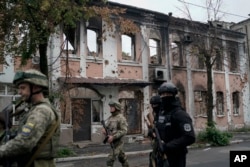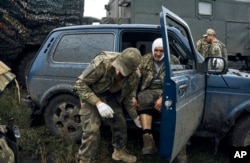The Chinese Communist Party’s No. 3 official, Li Zhanshu, made an official visit to Russia over September 8-9 to attend the 7th Eastern Economic Forum in Vladivostok.
Li met with Russian President Vladimir Putin, State Duma Chairman Vyacheslav Volodin and other political figures.
Li signaled support for Russia’s ongoing attacks on Ukraine and blamed the war on the West. He called for a strengthening of “exchanges” regarding “external interference, sanctions and long-arm jurisdiction.”
“The United States and NATO directly forced their way onto Russia's doorstep, which concerns Russia's national security and the safety of its people's lives. Under such circumstances, Russia has taken measures that it thinks should be taken,” Li said. “China understands that and provides coordinated responses on different aspects.
“In my opinion, it can be said that Russia was forced into a corner, and under such circumstances, Russia took a counterattack to safeguard the core interests of the country.”
The claim that Russia was “forced into a corner” or otherwise compelled by the West to attack Ukraine is false.
Li’s comments ignored several key facts that undermine the idea that Russia’s invasion of Ukraine was in response to actions by NATO, a defensive alliance.
- Ukraine removed its legal prohibition against joining NATO only after Russia annexed Crimea and took other aggressive actions against Ukraine in 2014.
- A recent Reuters report showed that Ukraine offered to take future NATO membership off the table in exchange for peace, a plan Putin rejected.
- Putin has telegraphed his imperial intent, consistently denying Ukraine’s right to exist.
- Moscow’s aggression prompted Finland and Sweden to seek NATO membership, and Russia’s response was muted.
- It is Russia’s actions that prompted NATO countries to beef up defenses.
So, let’s unpack this.
On September 14, Reuters, citing three people close to the Kremlin, reported that Putin’s chief envoy on Ukraine, Dmitry Kozak, had hammered out a provisional deal with Kyiv as the war began that would have satisfied “Russia's demand that Ukraine stay out of NATO” in exchange for peace.
But Putin rejected the offer and “expanded his objectives to include annexing swathes of Ukrainian territory,” the sources told Reuters.
Russia’s war against Ukraine actually started long before in 2014, when it annexed Crimea and fomented conflict in Ukraine’s eastern provinces, clandestinely helping create “independent” people’s republics that are puppets of the Kremlin.
As Polygraph.info previously reported, Ukraine had dropped its pursuit of NATO membership in 2010 and passed a law affirming its status as a military non-aligned country, a status that precludes joining NATO.
Ukraine only abandoned its non-aligned status in December 2014, after Russian troops occupied Crimea and became directly engaged in fighting on Ukrainian soil, including during the Battle of Ilovaisk in August-September 2014.
Still, NATO has never offered Ukraine a Membership Action Plan — the official pathway for entry to NATO.
Moreover, it was Russia’s attacks on Ukraine that prompted NATO to bolster its defensive forces in response, and the U.S. and its European partners to later spend billions on arms and ammunition for Ukraine.
“In response to Russia's use of military force against Ukraine, NATO deployed four multinational battle groups to the Baltic States and Poland in 2016. Before Russia's illegal annexation of Crimea, there were no Allied troops in the eastern part of the Alliance,” NATO said.
The recent decisions by Sweden and Finland to join NATO also show that Russia’s concerns over NATO expansion are overblown.
Following Russia’s invasion of Ukraine, Finnish leaders said in May that “Finland must apply for NATO membership without delay.” Days later, Sweden’s foreign minister signed the country’s application to join NATO.
Finland and Sweden officially applied to join NATO on May 18.
But while Russia first warned of “retaliatory steps” against the two countries, it later signaled that their NATO membership would not be an issue.
“We don't have problems with Sweden and Finland like we do with Ukraine,” Putin said in late June.
What problems does Russia have with Ukraine?
According to some Russian pundits, and Putin himself, Ukraine is wrong to believe it has a right to exist as an independent country with a unique national identity.
In 2008, Putin told then-U.S. President George W. Bush: “You have to understand, George, Ukraine is not even a country.”
In a July 2021 article titled, “On the Historical Unity of Russians and Ukrainians,” Putin wrote “that Russians and Ukrainians were one people – a single whole.” He also claimed “there is no historical basis” for “the idea of Ukrainian people as a nation separate from the Russians.”
Underscoring Russia’s expansionist ambitions, Putin said, “Kyiv simply does not need Donbas,” the region in eastern Ukraine where Russia helped establish separatist republics and which Russian forces now occupy.
On the eve of Russia’s full-scale invasion in February, Putin argued in a televised address that Ukraine never had “real statehood,” adding that the country was an integral part of Russia’s “own history, culture, spiritual space.”
Putin also claimed that Ukraine could be called “Vladimir Ilyich Lenin's Ukraine,” falsely arguing that Ukraine was the Soviet dictator’s creation.
In a June speech in which he compared himself to Peter the Great, Putin claimed that through the war in Ukraine, he, like the imperial Russian monarch, was returning Russian lands.
In July, Russia signaled its intent to grab even more territory in southern Ukraine.
Moscow’s plans to hold bogus referendums on joining Russia in occupied Ukrainian territory were reportedly thwarted by Ukraine’s recent advances on the battlefield.
Top Russian officials and media pundits regularly use genocidal language concerning Ukraine.
A prominent Russian state media pundit compared Russia’s actions in Ukraine, some of which are alleged war crimes, to removing “worms” from a sick cat.
Vladislav Surkov, a former chief Kremlin ideologue who advised Putin on matters concerning Russia’s clandestine actions in eastern Ukraine, said in 2020 that “[t]here is no Ukraine. There is Ukrainian-ness,” which he defined as “a specific disorder of the mind.”
Such rhetoric is normalized on Russian state TV and other state media, despite an extremism law that criminalizes incitement of hatred against ethnic groups.








